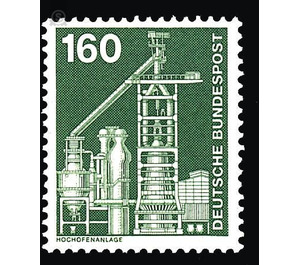Postage stamps: industry and technology - Germany / Federal Republic of Germany 1975 - 160 Pfennig
Theme: Economy & Industry
| Country | Germany / Federal Republic of Germany |
| Issue Date | 1975 |
| Face Value | 160.00 |
| Color | green |
| Perforation | K 14 |
| Printing Type | Typography |
| Stamp Type | Postage stamp |
| Item Type | Stamp |
| Chronological Issue Number | 746 |
| Chronological Chapter | GER-BRD |
| SID | 94767 |
| In 56 Wishlists | |
A new postage stamp continuous series with representations from industry and technology replaces the postage stamp continuous series "Federal President Heinemann". The postage stamps to 80 Pfennig, 120 Pfennig and 160 Pfennig appear as further values of this series with the inscription Deutsche Bundespost (at the same time and same motives the stamps come out also with the inscription Deutsche Bundespost Berlin, the first three values are on 15 May 1975, further three values were issued on August 14, 1975) bear the following motifs: 160 Pf: Blast Furnace The selected motif shows a modern large blast furnace at the Rheinhausen plant of Friedrich Krupp Hüttenwerke AG. This large blast furnace, built as a substitute for several smaller blast furnaces, today produces more than half of the total pig iron volume of about 3.5 million tons produced per year by Friedrich Krupp Hüttenwerke AG. It can be observed throughout the Federal Republic of Germany that pig iron producers replace their plants with larger units. The advantages of these larger units are lower investment costs, lower personnel costs, lower coke consumption, increased performance by higher blowing temperatures and higher pressure on the gout (upper part of the blast furnace) and higher performance by enriching the blast furnace wind with oxygen. The large units have meant that, despite the reduction in the number of blast furnaces in operation, the pig iron capacity has been significantly increased. The technical progress achieved in the construction of blast furnace plants has meant that the production of pig iron in the blast furnace will continue to be the essential basis for crude steel production in the world.


